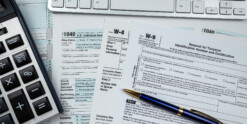Do you remember the Presidential Physical Fitness Award? If you were in school between 1966 and 2012, you may recall a time when your P.E. teacher would put you through a series of different exercises. Those who met or exceeded the benchmarks received a patch from the commander-in-chief himself. (Although I did always wonder why there wasn’t a hand-written note, too.)
Whenever it came time for the teacher to put us through our paces, I always knew where the real challenge lay. Sit-ups? Child’s play. One-mile run? Excuse my grandstanding, but I won the Hickory Hills Elementary Dragon Chase five years in a row. The shuttle run? No sweat, Mr. Clinton.
But alas, my nemesis was the dreaded “sit and reach.” For those of you who may not remember, this exercise was simply a hamstring stretch while you pushed a little marker as far as you could. I learned at a young age that I am not a flexible human. (This is still apparent when I try to do yoga with my wife and look on in envy as I grotesquely twist my body to mimic her lithe poses.)
As it turns out, flexibility is a good thing to have – in both your body and your financial plan.
In my work with Capital Investment Advisors, a firm whose mission is to help families find happiness in retirement, I’ve found that people are generally happier when they know they can walk away from work on their timetable. Now that’s flexibility at its finest.
For some, this means they’re putting in their two-week notice the next day. For others, the simple knowledge that, even if they aren’t mentally ready for retirement, they can step away from work at any time makes that morning commute less stressful. Everyone is different, and the age at which you are financially able to retire and choose to retire will depend on your specific circumstances.
Now, if that glorious moment arrives before you hit the “magical” age of 59½, and all of your assets are in retirement accounts (such as 401(k)s, IRAs, Roth IRAs and the like), then you, my friend, have the privilege of paying penalties to the IRS if you make early withdrawals. Talk about inflexible!
Picture this not-uncommon scenario: A couple in their fifties have been diligent contributors to their companies’ retirement plans, have lived within their means, and finally, have the kids out of the house. All of their investments are in their 401(k), and they have enough to generate the income for all the things they want from their retirement. Time to tell Human Resources to look for their replacements and brush up on those core pursuits, right?
Well, maybe not. People in this situation are limited on how they can access that nest egg without paying a 10% penalty to the IRS.
You can use the “72(t) Distribution Rule,” (named for the relevant section of the IRS code), which provides a few different methods for determining how much you can take out each year. The downside is that you are locked into that specific distribution amount for the longer of five years or until you turn 59½. This provision reduces your flexibility to take out more (or less) should you have the need.
Another strategy is called the Rule of 55, which states that if you separate from your employer in the year you turn 55, you can take penalty-free distributions from that company’s 401(k). I personally like this choice much more than the 72(t) Distribution Rule because you choose the distribution amount. In my opinion, the Rule of 55 is underutilized possibly because the IRS buries this option about halfway down the page on early distributions from qualified plans.
The Rule of 55 isn’t perfect. It doesn’t help if you retire before 55. If your money is in an “old” 401(k) or IRA, the Rule won’t work. Applying the Rule of 55 also often limits your 401(k) investment options, particularly in the area of income-oriented investments.
Now I know the question that’s on your minds: “How could the couple retire with an accessible bucket of money to cover the gap years until they can tap their retirement accounts without restriction?”
I’m glad you asked.
To prevent these pesky IRS penalties, our couple could simply divert a portion of their investments into a taxable brokerage account. These accounts were once a gold standard go-to for retirement savings, but the advent of tax-deferred retirement accounts has largely relegated brokerage accounts to high-income earners who max out their standard retirement plan contributions.
Now, don’t misunderstand me; the benefits of tax-deferred growth and dividends in your 401(k) or IRA will mean more assets in the long-run. But what good will that do if you can’t touch it (without a slap on the wrist) when you want to? Folks who have a good allocation among the holy trinity of accounts – Roth IRA or 401(k), Traditional IRA or 401(k), and taxable brokerage accounts – can put themselves in control of when they retire (and what their tax bill will look like when they do).
So, flexibility is key in planning for your retirement, particularly if you’re looking to bid farewell to work earlier than 60. Keep your options open; don’t feel like your 401(k) is the only account you can fund. Having multiple investment vehicles at your disposal can move you a bit closer to a happy retirement – on your terms.
If you want more insight into the tax treatment of your specific accounts, talk with your financial or tax advisor, especially if you’d like the flexibility to have an early retirement.
The original article appears here.
DISCLOSURE
This information is provided to you as a resource for informational purposes only and should not be viewed as investment advice or recommendations. This information is being presented without consideration of the investment objectives, risk tolerance, or financial circumstances of any specific investor and might not be suitable for all investors. This information is not intended to, and should not, form a primary basis for any investment decision that you may make. Always consult your own legal, tax, or investment adviser before making any investment/tax/estate/financial planning considerations or decisions.













